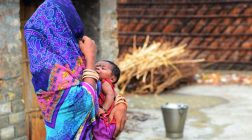Bill Gates: poverty eradicated by 2035 and innovative pharma growth in India, China and Brazil
Bill Gates: poverty eradicated by 2035 and innovative pharma growth in India, China and Brazil

Bill Gates is an optimistic philanthropist. He has predicted that almost no country will be in poverty by 2035, and has issued high praise to the vaccine world’s unsung heroes — Indian, Brazilian and Chinese pharmaceutical companies that are continuing to innovate and challenge traditional players in the sector.
The comments were made in the Bill & Melinda Gates Foundation’s annual letter and a blog for the World Economic Forum ahead of its annual meeting in Davos this week. The first was written as a call for others’ sustained optimism, and Gates used it to dispel three myths he says hold people back from donating to worthy causes: number one, that poor countries will remain poor no matter what we do; two, that foreign aid is a waste of tax money, and will be misspent because of corruption or lead to an unhealthy dependency; and three, that saving lives leads to overpopulation.
Gates smashes each myth, backing up his arguments with stats on GDP per capita versus annual spend.
He begins by partially blaming the consensus among reluctant givers on historical myths — namely the idea of the developed West versus everyone else: those behind the Iron Curtain and the remaining “third world”. While this might have been the case at one point, it no longer is he argues, pointing to the fact that nations such as Chile and Turkey now have a per-person income on a par with the US in the 60s and life span has soared in sub-Saharan Africa where 75 percent of children now attend school.
Barring war and political issues (such as those in North Korea), Gates says: “I am optimistic enough about this that I am willing to make a prediction. By 2035, there will be almost no poor countries left in the world. Almost all countries will be what we now call lower-middle income or richer. Countries will learn from their most productive neighbours and benefit from innovations like new vaccines, better seeds, and the digital revolution. Their labor forces, buoyed by expanded education, will attract new investments.”
Gates goes on to explain that US foreign aid is just one percent of national budget, that the US spends 60 times more on the military than on health aid and that corruption among recipients is a rarity, no matter what the papers say. A January announcement by the Foundation to mark three years since India has had a case of polio cements Gates’ statement that commitment to a problem can end in a satisfactory solution — it is not an endless uphill battle.
These solutions will partially come in the form of financial aid, but as with anything it’s where that aid is going. Gates has made a point of marking out India, Brazil and China’s pharmaceutical industry for its innovations and progress. As with many of the best innovations, part of these countries’ success is down to necessity.
In India, for instance, a national vaccine was developed for Japanese encephalitis in 2013 by members of the Indian Council of Medical Research (ICMR), the National Institute of Virology (NIV) and Bharat Biotech International. Until the point the vaccine was launched, the country was dependent on Chinese imports. Although it’s more expensive than the Chinese version for now, at 50 rupees (48 pence) extra, the government will be providing it free to the public. It means the country does not need to rely on costly import procedures before getting it into the national health network, and it was engineered specifically to target the Indian strain. “Therefore, it is expected to improve the efficacy besides availability and affordability,” commented health minister Ghulam Nabi Azad at the launch.
Elsewhere, India’s pharma sector has ended up being sued on many occasions for another type of necessary innovation — its generics (not to be confused with genetics) business. German pharma company Bayer launched Sorafenib tosylate, a drug for those suffering from advanced kidney and liver cancer, in 2005 and gained an Indian patent in 2008. Two companies, including Natco, began developing a generic version in 2010 and asked Bayer for voluntary license to sell the drug. Bayer never replied, but the Drug Controller General of India issued the company a license to manufacture and sell it, paying six percent in royalties to Bayer. In 2013 an Indian court threw out Bayer’s case when it attempted to sue Natco and halt manufacturing — under the Trade-Related Aspects of Intellectual Property Rights (Trips) agreement, compulsory licenses can be issued, as was the case in India, if drugs from abroad are certified as unaffordable.
At the time, Bayer was selling the drugs at 280,000 rupees (£2,743) a month versus Natco’s 8,800 rupees (£86.20), and reaching just two percent of the population. It demonstrates how pharmaceutical companies in India have risen to the challenge and answered a national need — it’s something other countries can learn from, but also something others can benefit from when their attention focusses on vaccines and other high demand necessities. Indian courts have scuppered the patents of drugs manufactured by some of the largest pharmaceutical companies in the world, including Pfizer Inc, Roche Holding AG and Merck & Co, with medicines targeting asthma, hepatitis C, cancers and more.
The pharmaceutical sector’s rise has also afforded it the ability to produce low cost vaccines under $30 (£18) for some of the most common, and deadly diseases in the world, including tetanus, whooping cough and polio, says Gates.
“You have probably never heard of many of the pharmaceutical companies — Serum Institute of India, Bharat Biotech, Biological E, China National Biotec Group, and Bio-Manguinhos, to name just a few — that have become some of our most valuable partners in global health. By harnessing the same innovative spirit that transformed emerging markets into manufacturing hubs for everything from cars to computers, these companies have become leaders in supplying the world with high quality, low-cost vaccines.”
Gates cites the pentavalent vaccine, which protects against diphtheria, tetanus, whooping cough, hepatitis B, and haemophilus influenza type b and in 2001 cost $3.50 (£2.10) through the Bill & Melinda Gates Foundation’s GAVI Alliance, designed to deliver vaccines worldwide. Because of competition in the sector, and the demand for a low cost version, Indian company Biological E is now selling it for $1.19 (72p).
Gates goes on to cite a series of developments in the past few months:
“India’s Department of Biotechnology and Bharat Biotech announced plans this year to release a new vaccine against rotavirus — which kills hundreds of thousands of children — for $1 per dose, significantly cheaper than existing vaccines. Likewise, a Chinese biotech company won approval in October from the World Health Organisation to bring to market an improved vaccine protecting children against Japanese encephalitis. The same month, Brazil’s top biomedical research and development center, Bio-Manguinhos, in partnership with the Gates Foundation, announced plans to produce a combined measles and rubella vaccine.”
Because of the success of competition in the pharmaceutical sector, we no longer have to rely on drugs belonging to the few, big players. But the ones to watch, says gates, continue to be those in the emerging — really emerged and booming – markets like India, China and Brazil (patent disputes not withstanding).










